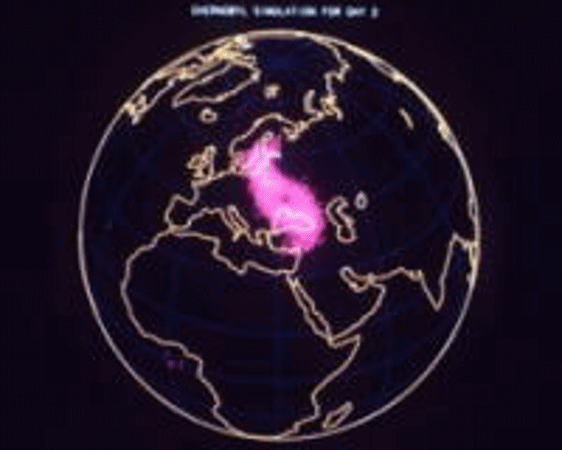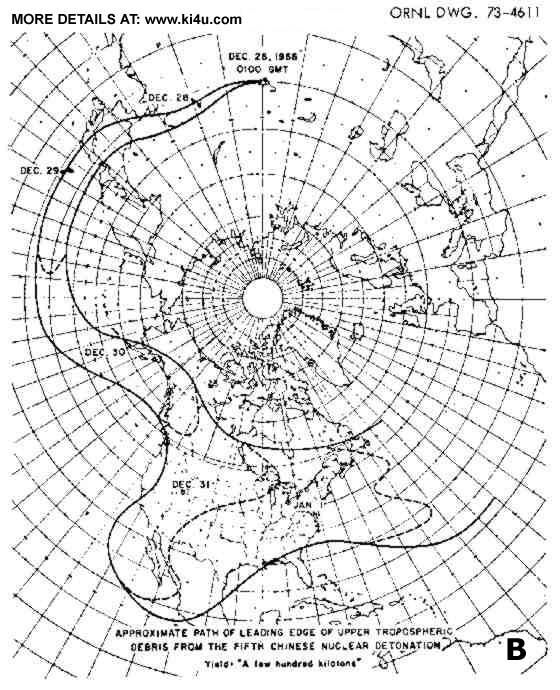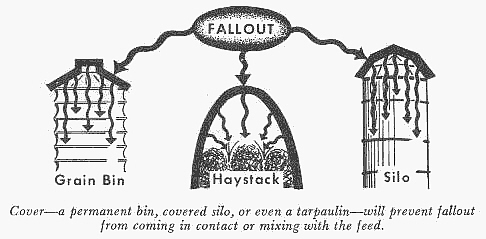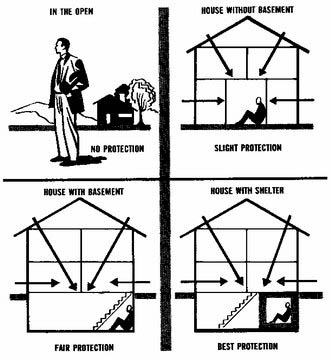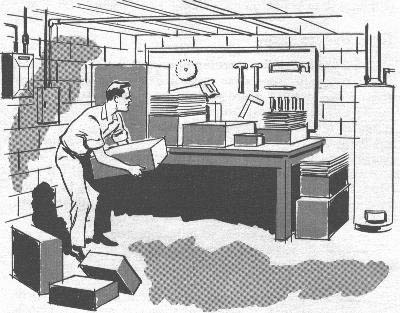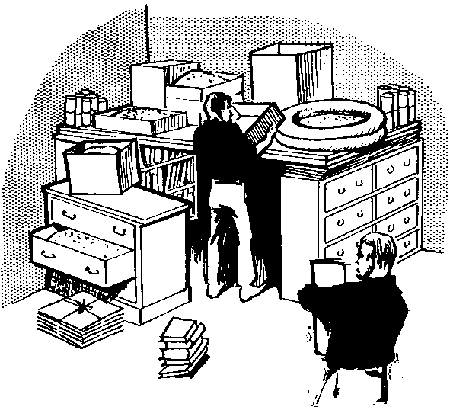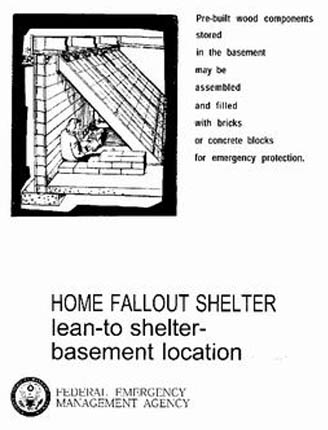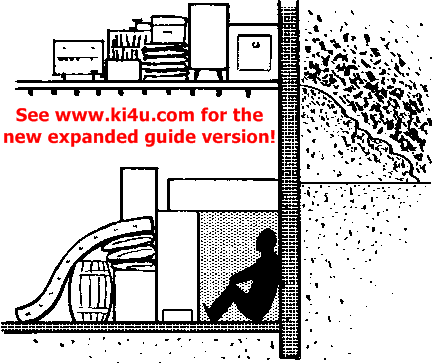The important thing to recognize in the charts above is that here in the
Northern Hemisphere, via upper wind Prevailing Westerlies, anything unleashed
to the west of the USA could be coming here next.
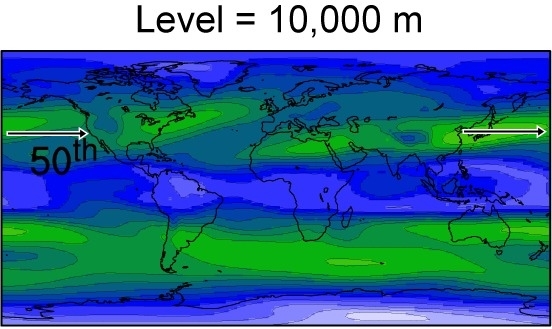 In a future In a future
event, if not huge and/or multiple releases, most people very far downwind
will either not experience any radioactive fallout, or not of high enough
quantity and intensity, to be of significant concern. However, there can be
exceptions, as detailed below. Most watched today, for future radioactive
fallout and radiation contamination, is from Japans' Fukushima reactor releasing
radioactive contaminants into the air, that could next be drifting downwind
towards North America...
 Other future potential risks include Iran and North Korea, where their nuclear facilities could be bombed, releasing radioactive contaminants into the air, drifting downwind, too. Other future potential risks include Iran and North Korea, where their nuclear facilities could be bombed, releasing radioactive contaminants into the air, drifting downwind, too.
There will be a big difference whether the 'event' is a nuclear power plant accident or conventional bombs used in Iran or North Korea or actual nuclear weapons, as well as in how many locations in Iran or North Korea, in both how much fallout is created and how high it is ejected into those upper winds, that will affect greatly how much and far downwind the fallout will then be a serious threat. Of course, anything could happen anywhere anytime, like it has now in Japan, not just from Iran or North Korea in the future.
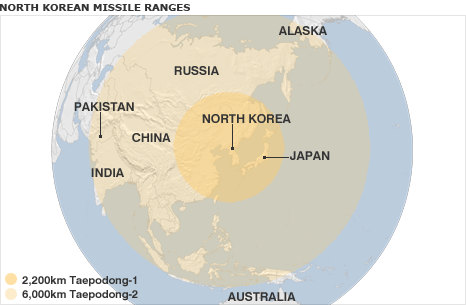 Other areas of concern, besides Iran or North Korea, are from other countries in the Mid-East, South Korea, Pakistan, India, Russia, China, or even another Chernobyl or Three Mile Island anywhere, like in Japan today, etc. Other areas of concern, besides Iran or North Korea, are from other countries in the Mid-East, South Korea, Pakistan, India, Russia, China, or even another Chernobyl or Three Mile Island anywhere, like in Japan today, etc.
There would be justifiable concern for those immediately downwind and thus protective actions that
they will need to promptly undertake to protect themselves from radioactive fallout and radiation contamination. Usually either evacuation or sheltering, along with prophylactic Potassium Iodide (KI)
for protection against radioactive iodine. (More on that below.) Much further downwind, like here in
USA, the effects will be substantially less pronounced, though some measured protective actions, like Potassium Iodide (KI), may be indicated in some areas.
For everyone, though, without the basic knowledge presented here, they risk unnecessary
panic that could become even more widespread than the fallout itself.
It's hard to say how much fallout will fall here from overseas, like Japan or Iran or North Korea, until it does, but it's very unlikely that it would ever be enough to require Americans to utilize fallout shelters to survive it, as they would if a nuke was exploded upwind of them right here in America, as detailed in
What To Do If A Nuclear Disaster Is Imminent! at www.ki4u.com/guide.htm.
The fallout threat here in the USA, from an 'event' originating far overseas, like Iran or
North Korea or Japan, will be based upon four factors;
- Type and quantity of radioactive isotopes unleashed; nuclear fission bomb(s) or nuke power plant or nuclear materials facility. - Resulting plume or mushroom cloud altitude and wind direction and speed. - Distance and time before arriving at your location. - Ultimate isotope type and quantity falling out at your specific location. What is radioactive fallout?
Radioactive fallout is the particulate matter (dust) produced by a nuclear explosion and carried
high up into the air by the mushroom cloud. It drifts on the wind and most of it settles back to
earth downwind of the explosion. The heaviest, most dangerous, and most noticeable fallout,
will 'fall out' first closer to ground zero. It may begin arriving minutes after an explosion. The smaller
and lighter dust-like particles will drift much farther downwind, often for hundreds of miles.
Higher ejected fallout can even travel thousands of miles for weeks. Once it arrives, whether
visible or not, most that will fall will have done so usually in under an hour once it begins, coating
everything just like dust does on the ground, cars, trees, roofs, etc. Often visible as a fine dark
grit on white surfaces, but not always.
However, rain can concentrate the fallout into localized 'hot spots' of much more intense radiation
with no visible indication. For instance, as happened in Troy, NY in April 27, 1953 when a
thunderstorm rained down fallout there, from a nuclear test in Nevada two days earlier, that
produced readings up to a thousand times higher than normal background radiation, equivalent
to readings taken only 200 miles away from the test site in Nevada. More details about this
'rainout' at "Thunderstorm in Troy" at http://74.125.155.132/scholar?q=cache:fNUVgxa5OEUJ:scholar.google.com/&hl=en.
If not an actual nuke explosion, though, like with nuclear facilities at Japans' Fukushima reactor,
the fallout from Japan should not rise as high without the mushroom cloud of a conventionally
exploded nuclear bomb. Thus, more of the radioactive fallout from Japanese nuclear facilities
would not fall as far away, but be concentrated more inside Japan and the neighbors of Japan
on the map immediately downwind.
The terms "radiation" and "radioactivity" are often confused. The proper relationship between
the terms is that "radioactive atoms emit radiation." This radioactive fallout 'dust' is
dangerous because it is emitting alpha, beta and, most importantly, penetrating gamma radiation
(similar to x-ray's). This gamma radiation (not the radioactive fallout dust) can go right through
walls, roofs and protective clothing. Even if you manage not to inhale or ingest the dust, and
keep it off your skin, hair, and clothes, and even if none gets inside your house, the radiation
penetrating your home could still be extremely dangerous, and can injure or kill you inside.
BUT, ONLY IF the quantity and intensity of the fallout at your specific location was
high. The further downwind, especially from fallout originating far overseas, and
baring any rainouts as described above, that sparse fallout and its declining radiation
will be very much less dangerous, both from the natural atmospheric dispersion and
natural decay over time before it arrives.
| Radioactive fallout from a nuclear explosion, though very dangerous initially, loses its intensity quickly because it is giving off so much energy. For example, fallout emitting gamma ray radiation at a rate over 1000 R/hr (fatal with half hour of exposure) shortly after an explosion, weakens to only 1/10th as strong 7 hours later. Two days later, it's only 1/100th as strong, or as deadly, as it was initially. And, two weeks later, it is only 1/1000th as strong as it was initially. (However, radioactive fallout from sources other than a fission nuclear explosion, such as conventionally bombed nuclear processing facilities in Iran or from a nuke plant meltdown, will likely have a higher percentage of isotopes of longer lasting duration, but fortunately likely not get ejected up into the upper winds as much to travel as far, compared to if a nuke was detonated.) | 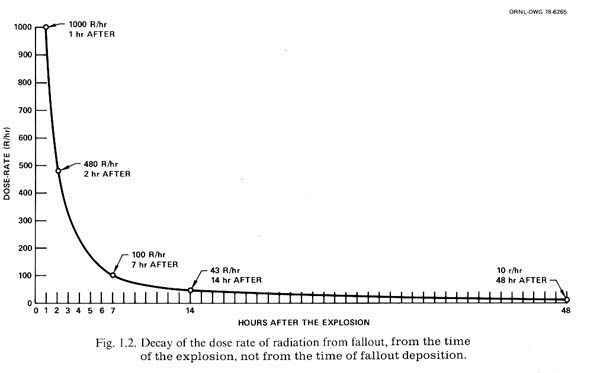 |
A nuclear explosion creates a fallout 'soup' of 200 or so different radioactive isotopes, that become ever more dispersed over distance downwind, weakening with every passing hour, and whatever little still remains far downwind, that we might later inhale or ingest then, is even further dispersed in our bodies. They pose much less of a risk then than if they were to be concentrated into one small specific area of the body, like radioactive iodine (radioiodine) does in our thyroid glands.
The most widespread concern we would most likely see here, if anything...
...from well dispersed fallout originating from far overseas, will be from ingesting and/or inhaling radioiodine, mostly Iodine-131 (I-131). Radioiodine could also contaminate pastures, livestock and crops, most especially dairyland pastures and ultimately milk supplies for up to a month. Radioiodine has been long proven to be a major constituent of both nuclear explosions and nuclear power plant mishaps and is especially of concern as it uniquely re-concentrates itself into our tiny thyroid glands giving that gland a much higher dose and the highest risk for cancer later.
From http://en.wikipedia.org/wiki/Potassium_iodide we see reported that:
Chernobyl also demonstrated that the need to protect the thyroid from radiation was greater than expected. Within ten years of the accident, it became clear that thyroid damage caused by released radioactive iodine was virtually the only adverse health effect that could be measured. As reported by the NRC, studies after the accident showed, that "As of 1996, except for thyroid cancer, there has been no confirmed increase in the rates of other cancers, including leukemia, among the...public, that have been attributed to releases from the accident." We also saw this thyroid radioiodine connection with our own Nevada atomic bomb testing program in the 1950s and early 1960s. The National Cancer Institute Study Estimating Thyroid Doses of I-131 Received by Americans From Nevada Atmospheric Nuclear Bomb Tests 'worst case' estimate is that fallout from nuclear weapons testing here likely generated from 10,000 to 75,000 cases of thyroid cancer. Each year, more than 12,000 Americans find out they have thyroid cancer, though from various causes. About 1000 here in the U.S. die from it annually.
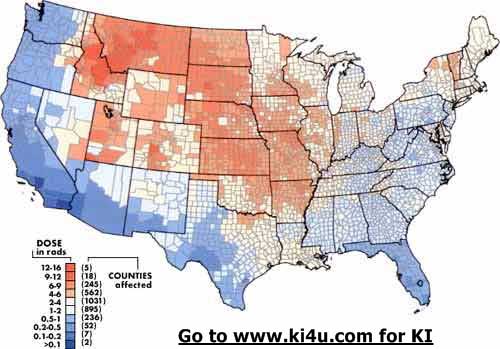
National Cancer Institute Study Estimating Thyroid Doses of I-131
Received by Americans From Nevada Atmospheric Nuclear Bomb Tests
The NCI's 'worst case' estimate is that fallout from nuclear weapons
testing likely generated from 10,000 to 75,000 cases of thyroid cancer!
Executive Summary of that report here.
Critique of NCI report and more here. |
Health physicist experts agree that the greatest health concerns, affecting the largest number
of people far downwind, from a nuclear power plant accident or nuclear bomb explosion(s)
anywhere in the world, will likely be from that release of radioiodine that is then carried
downwind for hundreds and even thousands of miles. Inhaling radioiodine will be a concern
downwind, though radioiodine contaminating the food supply and, in the public's mind making
it all suspect, could become the bigger concern. Milk will be atop the list with its short time
from pasture to cow to milk on your table. More about radioiodine and very effective, simple
and inexpensive protective measures below.
Unfortunately, the public is generally not well educated on nuclear threats and fallout, and
stirred up by sensationalist media reports of potential food contamination, could unleash a
widespread panic run on food stores and other supplies. Understanding that real potential
for future panic would make it prudent for families to have calmly stocked up beforehand,
as they should for any natural disaster or, failing that, promptly at the very first indication
of any developing nuclear emergency while locally available inventories are still plentiful.
Fallout coming here from nuke use in Iran, Pakistan, India, Mid-East, Korea,
Taiwan, China, Russia, Japan, etc.
The best documented case for concern in the USA of having overseas radioactive fallout
raining down on us here, too, via prevailing westerly trade winds, with plenty of thyroid
contaminating radioactive iodine, can be found in the Nuclear War Survival Skills book.
This Oak Ridge National Laboratory, a Facility of the U.S. Department of Energy,
Updated and Expanded 1987 Edition, details the above and shows where a single,
and very small, above ground Chinese nuclear test explosion ("a few hundred kilotons")
on December 28, 1966 resulted in the fallout cloud covering most of the United States.
(See map 'B' above.)
Cresson H. Kearny, the author of the NWSS book, also states about this now declassified
incident:
"It produced fallout that by January 1, 1967 resulted in the fallout cloud covering most of the United States. This one Chinese explosion produced about 15 million curies of iodine- 131 - roughly the same amount as the total release of iodine- 131 into the atmosphere from the Chernobyl nuclear power plant disaster." "Fallout from the approximately 300 kiloton Chinese test explosion shown in Fig. 1 (Map 'B' above) caused milk from cows that fed on pastures near Oak Ridge, Tennessee and elsewhere to be contaminated with radioiodine, although not with enough to be hazardous to health.""However, this milk contamination (up to 900 picocuries of radioactive iodine per liter) and the measured dose rates from the gamma rays emitted from fallout particles deposited in different parts of the United States indicate that trans-Pacific fallout from even an overseas nuclear war in which "only" two or three hundred megatons would be exploded could result in tens of thousands of unprepared Americans suffering thyroid injury." "Perhaps the first nuclear war casualties in the United States will be caused by fallout from an overseas nuclear war in which our country is not a belligerent. As the number of nations with nuclear weapons increases - especially in the Middle East - this generally unrecognized danger to Americans will worsen." "Trans-Pacific war fallout, carried to an America at peace by the prevailing west-to-east winds that blow around the world, could be several hundred times more dangerous to Americans than fallout from the worst possible overseas nuclear power reactor accident, and many times more dangerous than fallout from a very improbable U.S. nuclear power reactor accident as lethal as the disastrous Chernobyl accident was to Russians." The 280 page Nuclear War Survival Skills book can be viewed free on-line here as pdf
and hard copies acquired here. (This book also covers and details family nuclear preparations
for much more than just the threat of radioiodine fallout, too.) BTW, The maximum measured
radioactive contamination of milk in the United States by radioiodine from the Chernobyl disaster
(Map 'A' above) was in milk produced by cows grazing on pasture in Washington: 560
picocuries per liter. Customary levels are normally 2-3 picocuries per liter.
Fortunately, there is a cheap and effective preventative method to protect yourself
and family from radioactive iodine.
Potassium Iodide (KI) tablets, taken a half hour or more before exposure, and then
for the next 7-10 days, saturates your thyroid gland with safe stable iodine where if you
then later inhale or ingest radioactive iodine your body simply eliminates it. It provides
nearly 100% protection from radioiodine and resulting thyroid cell damage and abnormalities,
such as loss of thyroid function, nodules in the thyroid, or thyroid cancer.
From http://en.wikipedia.org/wiki/Potassium_iodide we see reported about KI use during
Chernobyl event that:
Poland, 300 miles from Chernobyl, also gave out KI to protect its population. Approximately 18 million doses were distributed, with follow-up studies showing no known thyroid cancer among KI recipients. But time has shown that people living in irradiated areas where KI was not available have developed thyroid cancer at epidemic levels, which is why the US Food and Drug Administration (FDA) reported "The data clearly demonstrate the risks of thyroid radiation...KI can be used [to] provide safe and effective protection against thyroid cancer caused by irradiation." But equally important to the question of KI is the fact that radiation releases are not "local" events. Researchers at the World Health Organization accurately located and counted the cancer victims from Chernobyl and were startled to find that "the increase in incidence [of thyroid cancer] has been documented up to 500 km from the accident site...significant doses from radioactive iodine can occur hundreds of kilometers from the site, beyond emergency planning zones." Consequently, far more people than anticipated were affected by the radiation, which caused the United Nations to report in 2002 that "The number of people with thyroid cancer...has exceeded expectations. Over 11,000 cases have already been reported." See the Potassium Iodide Anti-Radiation Pill FAQ for more details on the health concerns
of radioactive iodine, especially to our children, and for sources of thyroid protecting KI
tablets, including homemade alternatives if no KI tablets available, and you'll also see why
about.com says that FAQ is the..."In-depth, detailed site totally dedicated to the
Potassium Iodide issue. THE central resource on the topic."
With ever wider public education of nuclear threats and fallout, hopefully, unproductive
hysteria can be averted. Without that education, we risk the potential for unbridled panic
regarding both public exposure to fallout and contamination of exposed crops, livestock
and water.
As Cresson Kearny further details in the Nuclear War Survival Skills book:
"The public's exaggerated fears of extremely small amounts of radiation also are worsened by the media's use without explanations of very small units of radiation measurement, including the picocurie. (The picocurie is used to express the radioactive contamination of milk, water, etc., and is only one millionth of a millionth [1/1,000,000,000,000] of a curie.) One episode in which fears of radiation were thus worsened occurred shortly after the invisible fallout cloud from the Chernobyl disaster first reached the United States. Some listeners were frightened when a radio announcer merely stated that milk samples in northwest Oregon showed 118 picocuries per liter of radioactive iodine. Few Americans know that they will not be advised to stop using fresh milk unless its contamination is 15,000 picocuries or more per liter - as specified in the Food and Drug Administration's official, very cautious "Protective Action Guidance", published in the Federal Register of October 22, 1982." The current FDA Derived Intervention Levels (DILs) for Iodine-131 in food is 170 Bq/kg.,
which, for milk, works out to about 4,590 picocuries or more per liter. This is the level at
which the FDA may begin to warn the public not to use milk and/or issue an order to seize
or detain milk products.
Regarding fallout contamination, any food or water stored in sealed containers before the
fallout arrived, will always be safe to use. If any containers later had fallout dust on them
they can simply be brushed or rinsed off the outside of the container and then the contents
will be safe to use. As long as the fallout dust does not get inside the container, then
whatever radiation penetrated the food/water container from the outside does not harm
the contents. Having acquired sufficient stocks of food and water for your family beforehand
will be required if your area is affected and/or if public begins panic buying resulting in
shortages. In the extremely unlikely case that heavy fallout was anticipated here from an
overseas 'event', brief sheltering might be required as detailed in What To Do If A Nuclear
Disaster Is Imminent! at www.ki4u.com/guide.htm. There you would also learn more about
safe food and water storage and using common inexpensive N95 particulate respirator
masks and cheap hooded rain ponchos if getting to proper sheltering was delayed. Also,
it details simple decontamination if you suspect that your clothes, skin and hair have
fallout on them. Exposure to fallout radiation does not make you radioactive, but you
need to always minimize inhaling it, and maximize promptly getting out of it while properly
decontaminating to assure that you don't bring any inside. Before fallout arrives, you
might also try to cover up items you want to protect outside for easier rinsing off of the
fallout dust later when it's safe to come out and do so. For instance, if you have a
vegetable gardening spot, or cordwood stored outside for heating, you might try covering
some of it with plastic or tarp and weighting them down.
The more likely scenario here, from fallout originating from far overseas,
would at the most only require 7-10 days protection from radioiodine by taking
Potassium Iodide (KI) tablets and having pre-stocked safe food and water in
case people panic and stampede food stores.
In an emergency, if no more KI tablets available here, you can topically (on the skin)
apply an iodine solution, like tincture of iodine or Betadine, for a similar protective
effect. (WARNING: Iodine is NEVER to be ingested or swallowed, it is poison
to drink.) For adults, paint 8 ml of a 2 percent tincture of Iodine on the abdomen or
forearm each day, ideally at least 2 hours prior to initial exposure. For children 3 to 18,
but under 150 pounds, only half that amount painted on daily, or 4 ml. For children
under 3 but older than a month, half again, or 2 ml. For newborns to 1 month old,
half it again, or just 1 ml. (One measuring teaspoon is about 5 ml, if you don't have
a medicine dropper graduated in ml.) If your iodine solution is stronger than 2%,
reduce the dosage accordingly. Absorption through the skin is not as exact a dosing
method as using the tablets, but tests show that it will still be very effective for most.
More about the above at Plan B, along with formulas there for mixing up potassium
iodide (KI) solutions if you acquire KI powder or crystals. Do not use if allergic to iodine.
There are also a few other medical conditions and medications, discussed there, that are
contraindicated that your physician can best advise you about. Inquire of your doctor
NOW if there is any reason why anybody in your household should not use KI,
or iodine solutions topically applied on their skin, in a future nuclear emergency,
just to be sure. How radioactive fallout affects different food sources...
The following for farmers and ranchers, from the old USDA county defense boards,
should help dispel some of the potential panic. Old fashioned from the early 1960's,
but physics and tactics of radiation and fallout protection are timeless. This guidance
assumed nuclear explosion(s) and heavy fallout originating right here in the USA. Fallout
originating from far overseas would be many magnitudes less dangerous, but
the following is still very informative regarding the threat to, and vulnerability of, different
livestock & crops that we all rely upon in the food chain. References to
radioiodine below have been highlighted in blue.
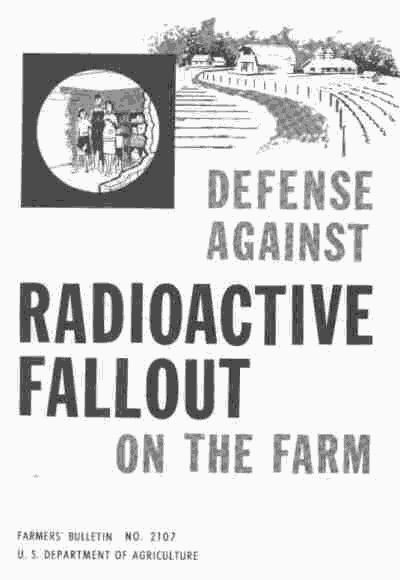
PROTECTING LIVESTOCK How will fallout affect unprotected livestock, that is, animals in fields, postures, and other open areas?
Fallout may be dangerous to cattle, sheep, horses, pigs, and other livestock as well as to human beings. Radioactive materials in fresh fallout can contaminate the immediate environment and give off rays that can penetrate deep into the body. This is the major source of danger for livestock. Animals can also suffer skin burns if fallout settles in the coat. Skin burns could produce considerable discomfort, but would not endanger the lives of the animals.
Animals are about as sensitive to radiation damage as human beings; to survive, animals need the same protection as human beings.
When livestock must graze on fallout-contaminated pasture, supplemental feeding from non-contaminated forage can materially reduce the daily dose of radioactive material the animals will eat. Stored or stacked hay, ensilage from either silo or trench, and stored grain are safe supplemental feeds when they are protected from fallout contamination. When no shelter is available and when the level of radiation is only moderate, or food resources are scant, growers should, if possible, supply supplemental feeding and limit the grazing time.
When meat and dairy animals eat contaminated feed, some radioactive elements are absorbed into their bodies. Thus, man's food supply of animal products can become contaminated with radioactivity.
How will fallout affect sheltered livestock?
Livestock housed in barns and other farm buildings during fallout have a better chance of surviving effects of radiation than those that are not sheltered. A reasonably well-built shelter reduces intensity of external radiation and prevents fallout from settling on the animals' bodies. It also prevents animals from eating contaminated feed.
What Is the best way to protect livestock from fallout?
Move them indoors as soon as possible. If you do not have adequate facilities to house all animals, put some of them near farm buildings or in a small dry lot. Under these conditions the amount of space per animal in a barn should be reduced to the point of overcrowding. The limiting factor is ventilation and not space. The advantage is that the animals tend to shield each other enough that more will survive under crowded conditions than under normal housing. Large, protected self-feeders and automatic live- stock waterers can supply uncontaminated feed and water.
Areas within movable fences, and other small fenced areas that have covered feeders or self-feeders, can provide emergency confinement for farm animals after early external radiation intensity has decreased through decay.
Empty trench silos can be converted to livestock shelters by constructing a roof over the trench and covering it with earth.
Once fallout occurs, you should not attempt to protect livestock unless local civil defense authorities tell you that you will be safe when doing so.
Get your dairy cattle under cover first.
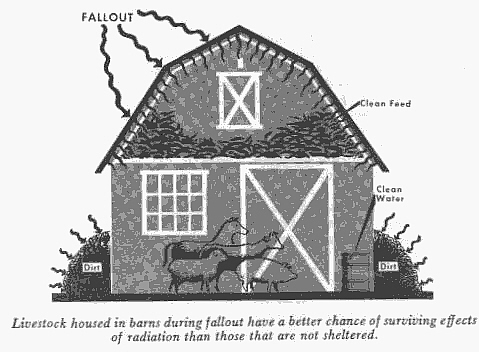
Water from a covered well, tank, or cistern, or from a freely running spring, is best. River water or pond water is less safe, but if necessary, it could be used after fallout has occurred. In a few days it would be safe. If, however, it should rain during this time, livestock should not be permitted access to pond water for an additional few days.
Usually, fallout particles would settle promptly and soluble radioactive materials would diffuse in the water, reducing the contamination at the surface. If the water was constantly replenished from an uncontaminated source, radioactivity would be diluted rapidly.
To prevent contamination from fallout, do not add water to covered tanks unless the water is from a protected well or spring; first use the water originally present in the tanks.
Could I use water in an exposed pond?
Water in an exposed pond would be contaminated, but usually the level of contamination would decrease rapidly. Such water could be used for surface irrigation. It could also he used to wash off farm buildings and unsheltered livestock. Obtain drinking water for livestock from another source if possible.
What feed can I give livestock after fallout?
To protect feed adequately, cover it. Fallout is like dust or dirt; a cover will prevent it from coming in contact or mixing with the feed.
Grain stored in a permanent bin, hay in a barn, and ensilage in a covered silo are adequately protected. They can be used as soon as it is safe to get to them following fallout.
A haystack in an open field can be protected with a tarpaulin or similar covering.
If possible, give your livestock feed that does not contain fallout material. Fallout particles that settle on hay, silage, or a stack of feedbags will contaminate only the outer parts. You can remove the outer layers or bags, and use the inside feed that is unaffected.
You will be notified if local civil defense and agricultural authorities who measure concentrations of fallout consider the forage growing in your area is harmful. However, this advice might come too late in heavily contaminated areas. As a precautionary measure, house the livestock and do not let them graze.
You may have to give cows contaminated feed if no other feed is available. The milk from these cows should not be used by children, but when the cows are back on clean feed, the amount of radioactive material in their milk will progressively diminish. If you have a question about the detection of harmful radiation, you should contact your local civil defense official or the chairman of your USDA county defense board.
What can I do with contaminated feed?
How long feed should be stored depends on the type and concentration of the radioactive materials. If you have an alternate supply, do not use contaminated feed until told by authorities that it is safe to do so; then be sure to follow the precautions they may recommend.
Should dairy cows receive special treatment?
Yes. Because radioactive materials can be transferred to milk, which will be a critical product during an emergency, make a special effort to protect cows from fallout. Remove milking cows from pasture and feed them stored rations during the period of fresh fallout and for several weeks after. In this way, you will prevent iodine 131 from occurring in the milk, or reduce it to insignificant levels.
Give cows preferred shelter and clean feed and water. If you can, milk them before fallout occurs; you may not be able to do so for several days afterward. If you have calves on the farm turn them in with the cows. This will help prevent mastitis and conserve all the feed for the cows. Reduce amounts of water and concentrated feed to maintenance levels.
Construction plans are available through State extension agricultural engineers for a combination dairy barn and family fallout shelter. Although construction of this type is costly, such a facility might be considered for the protection of highly valued breeding stock.
The plans are designed in accordance with milk production ordinances. They provide for (1) a year-round production Unit that requires minimum change for emergency use, (2) a built-in family fallout protection area that allows the operator to care for animals during a fallout emergency, (3) all stored feed that is manually accessible to be inside the barn, (4) stored hay and straw for use as shielding, (5) temporary housing, feed, and water for other livestock, (6) an auxiliary generator for assuring electric power, and (7) a water supply inside the barn.
What measures should be taken to protect poultry?
Measures for protecting poultry are the same as those recommended for other farm animals.
Poultry are somewhat more resistant to radiation than other farm animals. Since most poultry are raised under shelter and given feed that has been protected or stored, and since poultry can be grown rapidly, they are one of the more dependable sources of fresh foods of animal origin that may be available following a nuclear attack.
Hens that eat contaminated feed will produce eggs that contain some radioactive elements. Radioactivity in eggs decreases shortly after the hens are removed from the contaminated environment and given uncontaminated feed and water.
What animal food products are safe to market after fallout?
You will receive specific instructions from local civil defense authorities based on the amount of fallout received. Do not destroy any animal food products unless spoilage has made them inedible. Milk should be safe to use if it is from cows that are adequately sheltered and protected and are fed rations of stored and protected feed and water. Milk from a fallout area where cows are not adequately protected or fed stored feed should not be given to children until civil defense authorities approve. Milk contaminated with iodine 131 can be processed into butter, cheese, and powdered or canned milk, and stored for a period of time to allow the radioactivity to decay.
Food animals whose bodies have been exposed to external radiation can be used for food if they are slaughtered before the onset of signs of radiation sickness. Also, they can be used after they have recovered from the ensuing illness. The same rules that govern the slaughter of animals sick from any cause should be followed. Care must be taken to prevent edible parts of the carcass from being contaminated by radioactive materials contained on the hide and in the digestive system.
What do I do if animals die from fallout radiation?
Some of your animals may be affected so severely by radiation from fresh fallout that they will die in a few days or weeks after being exposed. Do not slaughter any of your livestock unless you are told to do so by local civil defense authorities or USDA county defense boards. Bury animals that die. These carcasses usually are not dangerous to surviving people or animals by the time it is safe to work outside.
Is it possible to decontaminate livestock and farm buildings that have been exposed to fallout?
If there is fallout on the animals’ skins, the radioactive material can be washed off with water. It is not necessary to use clean water sources for this purpose. Take care to avoid contamination runoff.
Civil defense authorities or USDA county defense boards may advise you on decontamination procedures for your farm buildings. In handling animals, wear coveralls, gloves, and boots to prevent contaminating yourself. Cleaning or disinfecting buildings will not destroy radioactivity. However, cleaning can be useful in moving radioactive materials to a place where radiation will be less harmful. In cleaning, be careful to avoid contaminating yourself.
PROTECTING LAND AND CROPS
What are the main consequences of heavy concentration of fallout on crop and pasture lands?
- Farm workers may not be able to manage and cultivate land safely for some time, because of radiation hazard.
- It may not be advisable to permit animals to graze, because of the danger of radiation.
- Fresh fallout would provide surface contamination on all plants, resulting in potential hazard to human beings and animals consuming them.
- Radiation from fallout deposited on the leaves or the ground may damage the crop.
How long would fallout affect cultivated and non-cultivated lands?
It would depend on the abundance and type of radioactive materials in a given area. In the event of nuclear attack, radioactive iodine would be the most critical single factor in the contamination of milk during the first few weeks. After the first 60 days, the principal hazard would arise from strontium 89 and strontium 90. Strontium 89, however, will have virtually disappeared 17 months after its formation.
Like other radioactive isotopes of fallout, strontium 90 falls on the surface of plants and can be consumed with foods and forage. Some of it is deposited directly on the soil or washed into it, remaining indefinitely, for all practical purposes, in the top several inches of uncultivated land. Because it is chemically similar to calcium, radioactive strontium would be absorbed by all plants. Plants growing in soils deficient in calcium would absorb more radioactive strontium than those growing in soils abundant in calcium, other conditions being equal.
Are there soil treatments for reducing the fallout hazard on land?
Yes, but soil treatments should be given only after responsible authorities have carefully evaluated the situation and declared a state of emergency. The most effective treatment could be costly, and suitable only for intensively used land.
Other methods involve changes in generally accepted farm practices. Some measures could be simply an improvement over local conditions and procedures. For example, liming of acid soils could reduce the uptake of radioactive strontium in crops grown on those soils.
USDA soil scientists in the USDA county defense boards will provide guidance to farmers in determining best utilization of their land following nuclear attack.
Any use of the land must wait until external radiation levels are low enough for persons to work safely outdoors.
Would fallout permanently affect pasture grass and forage crops?
If fallout is extremely light, the pasture would be usable immediately. It is difficult to set an exact external dose rate at which it would be safe to return the animals to pasture, but if the dose for the first week of stay did not exceed 25 roentgens all animals would survive and could be handled with safety.
If fallout is heavy, external radiation would prohibit use of the pasture. A heavy deposit of fallout would spread short-lived and long-lived radioactive particles on the pasture and forage crops. Radiation might cause visible injury to plants. Some plants might die.
Existing growths of alfalfa and other forage crops might not be usable because of radiation hazard. If a radiation survey should indicate that contamination level is high, existing growth should be removed as close to the ground as possible and discarded; succeeding growths should be used only after examination for radioactivity. If the soil is acid, a top-dressing of lime would help reduce uptake of radioactive strontium in succeeding growths.
Livestock could be allowed to graze on lightly contaminated pasture after a waiting period that varies from one to a few weeks, the length of time depending on the degree of contamination.
Once it is safe to work the land, a periodic check on pasture and produce in affected areas would provide the best safety guide to their use.
Would fallout affect my system of farming?
It could. Seriously contaminated land may need to lie fallow for as long as a season. After this, fallout may require a change to non-food crops or to food crops that do not absorb large amounts of radioactive materials from the soil. Alfalfa, clover, soybeans, and leafy vegetables have a greater tendency to absorb long-lived radioactive strontium than cereal grains, grasses, corn, potatoes, and fruits. Guidance on suggested crops to plant will come from USDA county defense boards.
Would fallout reduce economic productivity of crop and pasture lands?
Fallout might reduce such productivity in several ways: (1) Crop and soil management could be impeded because of danger from external radiation; (2) some crops might be killed by contamination; (3) other crops might become contaminated to a degree where they would be unmarketable; and (4) economic value of food grown on contaminated land might be less than that of other competitive crops.
What are the effects of fallout on growing vegetables?
Growing vegetables that are exposed to heavy fallout may become highly contaminated. Leaves, pods, and fruits that retain fallout material should be cleaned before being eaten. Washing is probably the most effective measure, just as it is the best way to clean garden foods that get dirty from any other cause. Radiation from heavy fallout may affect plant growth. Roots and tubers absorb little contamination from fallout before it is mixed with the soil. The normal cleaning or peeling of underground vegetables such as potatoes or carrots would be adequate for removing fallout.
What are the effects of fallout on fruits?
If fallout is heavy, ripe fruits may be lost because of the personal hazard involved in harvesting them. Fruits that do not have to be picked immediately can be saved. They should be washed before they are eaten.
Would fallout limit use of plants for human food?
It depends on the extent of radioactivity. Leafy vegetables, such as lettuce, should not be eaten unless they are thoroughly washed, or are known to be free of hazardous amounts of radioactive materials.
What special precautions should be taken for workers in the fields?
You should remain indoors until danger from fallout has diminished and you have learned from local officials that it is all right to work outdoors.
EMERGENCY DEFENSE SERVICES
By order of the President, the Secretary of Agriculture has put into effect defense services to protect farmer; their families, their livestock, and their agricultural productivity in event of a national emergency. The wide scope of these services enables them to function at all levels, national, State, county, and farm.
County Defense Boards
In preparing for a national emergency, the farmer may obtain guidance and assistance from his USDA county defense board. More than 3,000 of these boards are operating throughout the Nation. The USDA county defense boards receive direction from USDA State defense boards.
A USDA county defense board is composed of key USDA representatives in the county. The county office manager of the Agricultural Stabilization and Conservation Service usually serves as chairman. Other board members may include representatives of the Cooperative Extension Service, the Farmers Home Administration, and the Soil Conservation Service. Representatives of the Forest Service, the Agricultural Research Service, and the Consumer and Marketing Service, where available, are also members of the board.
Each USDA county defense board is equipped to serve the farmer in many ways. In most counties, the board chairman is responsible for food production programs. He will see that guidance is available in emergency farming practices and in conserving farm equipment, fuel, and manpower; he also will help obtain essential services or material.
The Soil Conservation Service member of the board will advise and assist in the proper use of land and water; and the Farmers Home Administration member will help the farmer in credit problems that may arise. The county extension agent will provide education on survival practices and protective measures for the farmer, his family, and his livestock.
The board chairman, or one of the board members, will advise farmers regarding other programs of USDA agencies that are not represented on the board. This might include, for example, assistance in protection of livestock and crops against the spread of disease or rural fire defense. Generally, the board chairman is responsible for USDA programs relating to food processing, storage, and distribution.
USDA county defense boards will work closely with and support county authorities. Farmers can look to their local county civil defense officials as well as USDA county defense boards for guidance in national emergency programs.
Radiological Monitoring
Radiological monitoring is measurement of the levels of exposure by radiation present in nuclear fallout. Special instruments and people trained in their use are required for this work.
Monitoring services would be needed in the early period following a nuclear attack to determine intensity of radiation on the farm. If this intensity were high, monitoring services would be needed later to determine when farming activities should be resumed. Examples of this monitoring service are detection and measurement of radiological contamination of farmlands, harvestable crops, forest land, and water and protection and handling of farm animals.
State and local governments are responsible for establishing comprehensive radiological monitoring systems in inhabited and habitable areas to measure and report radiation intensities. This monitoring provides the basis for survival and recovery. USDA is directly responsible for certain specialized monitoring:
- At major meat and poultry inspection installations.
- Of forest lands, agricultural lands, and water.
- Of federally owned stored food.
One or more USDA monitoring stations are established in each county in the United States. They provide capability to perform monitoring assigned to USDA, and they will also supply part of the radiological information needed for planning and directing local survival and recovery operations.
Office of Civil Defense guidance and the USDA Radiological Monitoring Handbook provide details for the necessary coordinated effort at the county level. Simply stated, county civil defense and the USDA county defense boards are responsible for joint planning and post attack advice to the farm population on precautions to take to minimize radiation exposures associated with farm work; county civil defense is responsible for most of the monitoring, reporting, and analysis of the data; and the USDA county defense board applies USDA guidance adjusted to local conditions in recommending appropriate:
- Care or disposition of livestock.
- Use of agricultural lands and water.
- Use or disposition of agricultural commodities. |
Bottom Line: Unfortunately, the federal government does not have large stocks of emergency KI tablets, nor is it likely what they do have can be gotten where it's needed and then to those who need it... in-time. Also, they no longer support nuclear Civil Defense training of the public, the USDA county defense boards, or county level radiation monitoring networks and fallout shelters*, as they once did during the heights of the Cold War, and thus American families are largely on their own today to find this important guidance and make their own preparations.
For this reason, we've produced both our myth-busting expose...
The Good News About Nuclear Destruction! at http://www.ki4u.com/goodnews.htm
...and our popular & essential family guide for...
What To Do If A Nuclear Disaster Is Imminent! at http://www.ki4u.com/guide.htm
Pass copies of them, along with this 'When An ill Wind Blows From Afar!' guide to friends, neighbors, relatives, fellow workers, churches and community organizations with a brief note attached saying simply: "We hope/pray we never need this, but just-in-case, keep it handy!" Few nowadays will find that approach alarmist and you'll be pleasantly surprised at how many are truly grateful.
|
